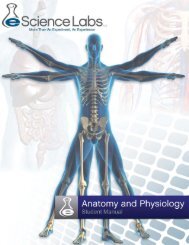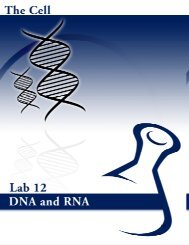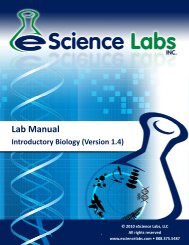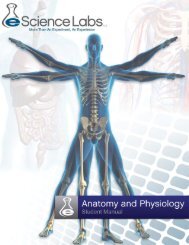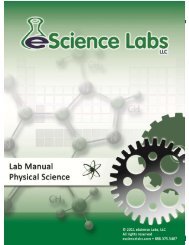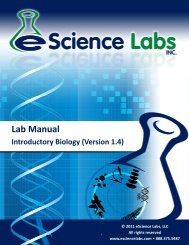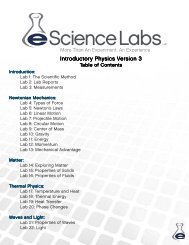Lab Manual - eScience Labs
Lab Manual - eScience Labs
Lab Manual - eScience Labs
Create successful ePaper yourself
Turn your PDF publications into a flip-book with our unique Google optimized e-Paper software.
<strong>Lab</strong> 12: Meiosis<br />
Concepts to explore:<br />
Concepts to explore:<br />
• Meiosis<br />
• Diploid cells<br />
• Haploid cells<br />
• Chromosomal crossover<br />
Introducon<br />
Meiosis only occurs in organisms that reproduce sexually. The process generates haploid (1n) cells<br />
called gametes (sperm cells in males and egg cells in females),<br />
or spores in some plants, fungi, and prosts, that<br />
contain one complete set of chromosomes. Haploid cells<br />
fuse together during ferlizaon to form a diploid cell with<br />
two copies of each chromosome (2n).<br />
There are over two meters of DNA packaged<br />
into a cell’s nucleus. It is coiled and<br />
folded into superhelices that form chromosomes,<br />
which must be duplicated before<br />
a cell divides.<br />
Genes are the units of heredity that have specific loci<br />
(locaons) on the DNA strand and code for inheritable<br />
traits (such as hair color). Alleles are alternave forms of the same gene (brown vs. blue eyes). Homologous<br />
chromosomes contain the same genes as each other but oen different alleles. Non-sex cells<br />
(e.g. bone, heart, skin, liver) contain two alleles (2n), one from the sperm and the other from the egg.<br />
Mitosis and meiosis are similar in many ways. Meiosis, however, has two rounds of division—meiosis I<br />
and meiosis II. There is no replicaon of the DNA between meiosis I and II. Thus in meiosis, the parent<br />
cell produces four daughter cells, each with just a single set of chromosomes (1n).<br />
Meiosis I is the reducon division– the homologous pairs of chromosomes are separated so that each<br />
daughter cell will receive just one set of chromosomes. During meiosis II, sister chromads are separated<br />
(as in mitosis).<br />
Each of the 23 human chromosomes<br />
has two copies. For each chromosome,<br />
there is a 50:50 chance as to which copy<br />
each gamete receives.<br />
That translates to over 8 million possible<br />
combinaons!<br />
131



